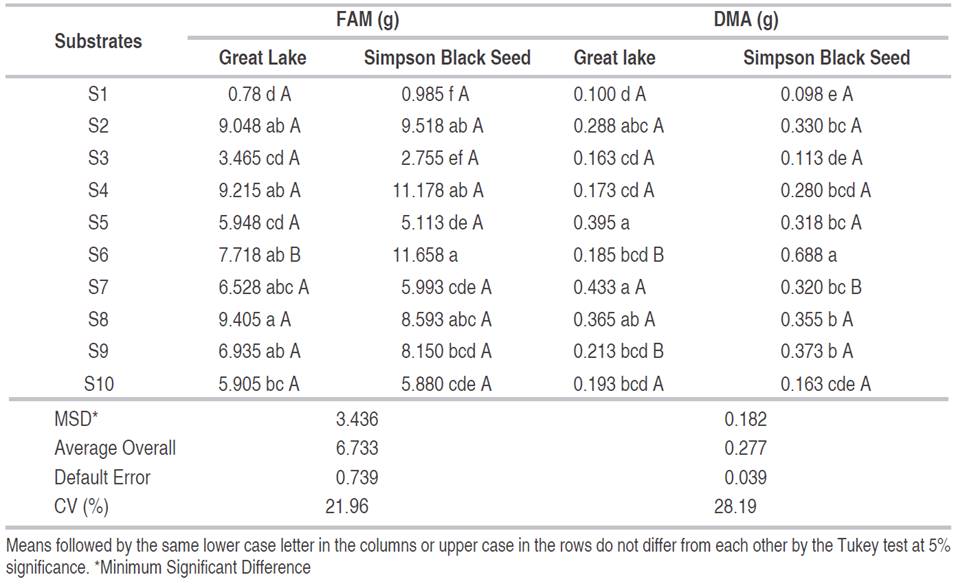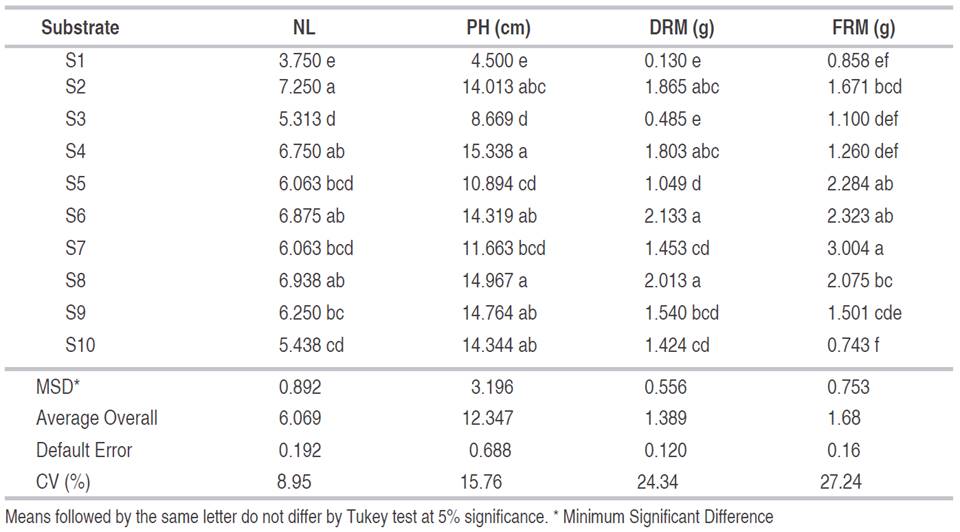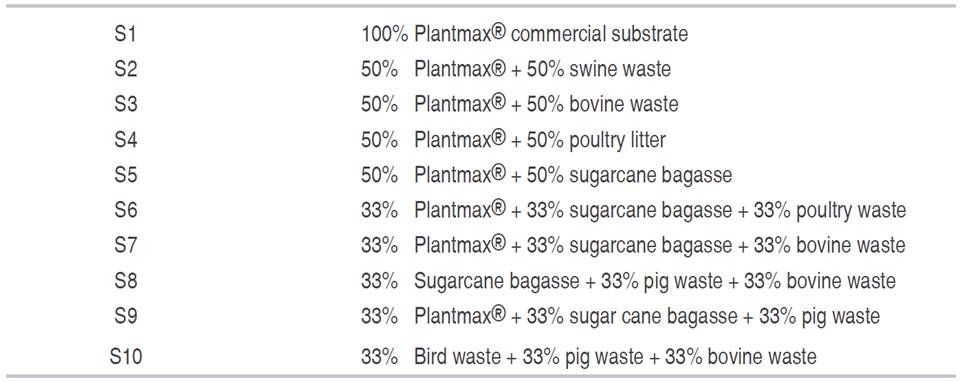Lettuce (Lactuca sativa) is a leafy vegetable belonging to the Asteraceae family. This vegetable is widely cultivated throughout Brazil, being an integral part of the great importance of the Brazilian diet (Antunes et al., 2016). This crop has an excellent adaptation to the climate of different Brazilian regions, low cost of production and presents possibility of growing all year in most of the country. Besides being very easy to market, it has a great economic and social importance (Medeiros et al., 2008).
Several factors influence the crop productivity, such as edaphoclimatic conditions and genetic factors related to cultivars and their adaptation to specific environmental conditions. In regions with high temperatures and high luminosity, the choice of cultivars that are not erect and tolerant because in such situations, there is a difficulty in forming the head and anticipation of the reproductive period, promoting the loss of quality and productivity (Souza et al., 2008). About 60% of a crop's success lies in planting good quality seedlings (Luz et al., 2010). The system of multicellular trays is the most used in the production of vegetable seedlings. Tomato seedlings, lettuce, cabbage, cauliflower, sweet pepper, and eggplant are currently produced in this system, using commercial substrates or substrates made by the producers composting organic waste (Marques et al., 2003).
In addition to the need to produce high quality seedlings, horticulturalists have the need to reduce the costs of the activity (Medeiros et al., 2008). One of the alternatives that should reduce costs associated with the production of quality seedlings is the use of organic compounds available in the production region. The intensive use of agricultural soils, specifically those originating from horticultural production, causes a decrease in organic matter and nutrients. Many authors such as Giannakis et al. (2014) and Pellejero et al. (2017) point out that the application of organic compounds in the soil has positive effects on the nutritional properties and on the quality of the harvested fruits.
A suitable substrate should not contain soil because of the presence of pathogens and weed seeds; besides, the seedling removal from the container with the whole lump is more complicated to handle (Boaro, 2013). A quality substrate must possess physical, chemical, and biological characteristics that provide adequate conditions for good germination, and that favors the development of the seedlings (Andrino, 2018), allowing a good development of roots and shoot. The properties usually used for the characterization of a substrate are pH, cation exchange capacity, salinity and organic matter content (Schmitz et al., 2002). For the chemical characteristics of a substrate, the pH must be in the appropriate range for the cultivation of the plant. Electrical conductivity is related to the availability of nutrients; it refers to the concentration of ionized salts in the solution (Kratz, 2015). Among the most important physical properties, the density of the substrate, the total porosity, the aeration space and the water holding capacity stand out. The biological characteristics are linked to the presence of pathogenic agents, such as nematodes, mites and phytopathogenic microorganisms, which can harm the development of the plant (Takane et al., 2012). One only material cannot bring together all the characteristics appropriate to the needs of the plants, therefore, it is a common practice to use mixtures to obtain the desired properties (Damiani and Schuch, 2009). In this context, the aim of this work was to evaluate the development of two lettuce cultivars produced using 10 different substrates.
MATERIALS AND METHODS
The experiment was conducted from March to April 2014 in a greenhouse located at the State University of Goias campus Santa Helena de Goias, Goias, Brazil, at coordinates 17°49'23"S 50°35'18"W. The region's climate is tropical, with rains concentrated in summer (October to April) and a well-defined dry period during winter season (May to September). The average annual temperature ranges 20 °C to 35 °C. A randomized block experimental design was used with a factorial scheme 2x10, with four replicates in duplicate (Table 1). The factors consisted of two lettuce cultivars: Great Lake (from the American group) and Simpson Black Seed (from the Crespay group) and 10 substrates.
Sowing was carried out in tubes with a volume of 127 cm3 (140 mm height, 37 mm diameter of the upper hole (without flap), 47 mm diameter of the upper hole (with flap) and 12 mm diameter of the lower hole. Cattle, poultry and pig residues were subjected to composting and then dried outdoor. After drying the residues, they were sieved to obtain a fine and homogeneous fraction, except the sugarcane bagasse and the commercial substrate Plantmax®, as these were already in ideal conditions to use.
After sowing, the tubes were kept in the greenhouse, and the evaluations were performed 30 days after sowing. Evaluated parameters:
Number of leaves (NL): it was counted in each plant.
Plant height (PH): it was determined from the base of the stem to the apex of the aerial part.
Fresh mass of the aerial part (FAM) and root (FRM): to obtain the fresh mass of the aerial part, plants were weighed by a precision scale right after the removal of the seedlings from the tubes. The same procedure was performed for the root system.
Dry mass of the aerial (DMA) and root (DRM): to obtain the dry mass, the weighed plants were used to obtain the weight of the fresh mass, and immediately afterwards, they were stored in an oven with forced air circulation at 65 ° C for 72 h to dry, until they reached constant mass.
The data were subjected to analysis of variance by the F test at 5% significance and the tukey test was applied to means using the Sisvar software.
RESULTS AND DISCUSSION
The interaction between the two evaluated factors (cultivars x substrates) affected the variables FAM (Table 2) DRM (Table 2). Simpson cultivar planted in the substrate S6-(33% Plantmax®+33% sugarcane bagasse+33% poultry litter) was higher than Great Lakes in this same substrate for the FAM variable (Table 2).
Table 2 Fresh mass of the aerial part (FAM) and dry mass of the aerial (DMA) regarding lettuce cultivars and 10 substrates.

Evaluating the FAM, the substrate S8 showed the best result for the Great Lake cultivar and the substrate S6 for the Simpson Black Seed cultivar, which allowed a greater formation of the aerial part of the plants during the seedling production phase, considering the leaves as a great source of assimilates for the other organs of the plants. Higher production of FAM part can result in better development of the seedlings after transplantation, since the seedlings with more developed aerial part have a greater capacity to withstand the stress caused by this process. According to Bellote and Silva (2010), leaves are one of the main sources of photoassimilates (sugars, amino acids and hormones) and nutrients for adaptation of post-planting seedlings, which require a good reserve of photoassimilates (water and nutrients for the roots).
The two studied cultivars influenced the PH and NL variables; however, no differences were observed for the interaction between them (Table 3). The Great Lakes showed better results than the Simpson Black Seed cultivar in the NL and PH. These variables referring to the aerial part, where Simpson Black Seed cultivar was higher than the FRM, demonstrating that under the experiment conditions, the Great Lake cultivar presented a higher development of the aerial part, while the Simpson Black Seed cultivar had a more robust root system.
Table 3 Number of leaves (NL), plant height (PH) and fresh mass of the root (FRM) as function of two cultivars.

The interaction between cultivar and substrates also affected the DRM, and differences between the two cultivars were observed in substrates S6, S7, and S9. In the interaction with the two evaluated cultivars, the substrates S6 and S9 provided seedlings with higher DRM for the Simpson Black Seed cultivar than for Great Lakes cultivar. However, for the S7 substrate, the Great Lakes cultivar produced DRM seedlings superior to the Simpson Black Seed cultivar (Table 4). The substrates that had sugarcane bagasse in their composition presented higher values of the dry mass of the root system than the substrates that did not have. Probably, this component provides better chemical and physical conditions for the good development of the root system of the seedlings. These differences in the dry mass of the root system resulted in more robust root systems that could allow greater absorption of water and nutrients. A good rooting of the seedlings and a rapid restart of the development of the plants are favored by tissues rich in dry matter after the stress caused by the transplanting process (Filgueira, 2005). The substrate used for the production of seedlings significantly influences the development of the root system, and this influence is mainly attributed to the quantity and size of the particles that define the aeration and the retention of necessary water for root growth (Kratz et al., 2013; Dutra et al., 2017; Andrino, 2018).
Table 4 Number of leaves (NL), plant height (PH), dry root mass (DRM), and fresh root mass (FRM) as a function of different substrates.

The different substrates influenced the NL per plant. A significant difference was observed for the two cultivars; however, no differences were observed for the interaction between the two studied factors. In addition to the NL per plant, the different substrates had effect on PH, FRM and DRM (Table 4).
The substrates S2, S4, S6 and S8, which contained commercial substrate in mixture with poultry or swine manure, with or without the addition of sugarcane bagasse, influenced the NL, being higher for the substrates with bovine waste than commercial substrate. A higher NL may stimulate the development of lettuce plants since the leaves are the main responsible for the production of assimilates in the plants. A greater production of assimilates may favor the growth and development of the plants before and after the transplanting process depending on the energy contribution, they contribute to the development of the root system (Table 4). The organic compound provided a higher NL compared to the substrates Plantmax® and washed sand (Medeiros et al., 2008). In general, the substratum constituted only by organic compound improved the length of the aerial part and root system and fresh mass of the aerial part and the root system, when compared with the commercial substratum (Monteiro et al., 2012).
For the PH and NL variables, the substrates S2, S4, S6 and S8 were superior to the commercial substrate and the commercial substrate mixed with bovine manure. However, for PH, the substrates S9 and S10, as well as the substrates mentioned above, also favored the development of seedlings in height (Table 4). Medeiros et al. (2008) observed that the organic substrate provided higher shoot height than the commercial substrate and washed sand. Substrates containing only swine manure are not recommended for the production of lettuce seedlings (Medeiros et al., 2016). Other authors observed that the commercial substrate presents better results than the substrates: sugar cane bagasse, filter cake, and the mixing in equal parts of cane bagasse with the commercial substrate (Freitas et al., 2013).
All treatments showed better results for the DMA, when using the commercial substrate combined with another constituent (S2 to S10), compared with the use of only commercial substrate (S1) (Table 2). Mixtures of substrate with pig manure, chicken bed, cane bagasse, chicken residue, bovine residue, (S2, S4, S6 and S8), presented the best results for PH (Table 4).
The substrates that contained commercial substrate and sugarcane bagasse in their composition, with or without the addition of wastes, favored the development of the root system, according to the FRM of the lettuce seedlings. In contrast, the seedlings with only commercial substrate (S1) and those cultivated with a substrate composed of the same mixture of swine, cattle, and poultry were the ones that provided the worse conditions for the development of the root system. Medeiros et al. (2008) observed a longer root length when lettuce seedlings were produced using organic substrate compared to a commercial substrate and washed sand as substrate. Freitas et al. (2013) observed that the commercial substratum Plantmax® only or in combination with any of the alternative substrates provided better results for the length parameter of the root system. Organic compounds as substrates in lettuce seedlings can replace a commercial substrate (Câmara, 2001).
CONCLUSIONS
The substrate with swine and poultry wastes was the one that favored the development of the aerial part of the seedlings and lettuce, while those with 33% of sugarcane bagasse favored the development of the root system. The commercial substrate, used in isolation, showed the lowest performance. Other proportions and mixtures can be tested in order to find new potential substrates for lettuce seedlings. To sum up, substrates with swine (for aerial part) and sugarcane bagasse (for root), had the best results.
















